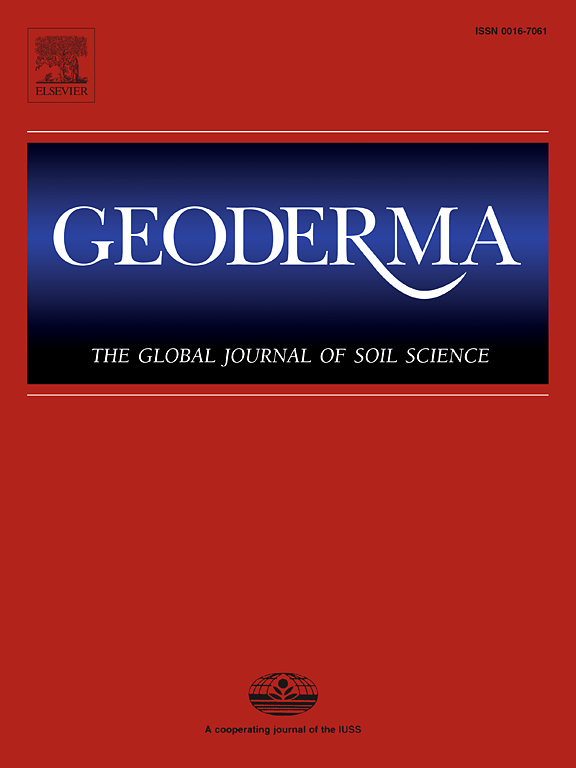Space-time modelling of soil organic carbon stock change at multiple scales: Case study from Hungary
IF 5.6
1区 农林科学
Q1 SOIL SCIENCE
引用次数: 0
Abstract
The role of soil organic carbon (SOC) is crucial not only for numerous soil functions and processes but also for addressing various environmental crises and challenges we face. Consequently, the demand for information on the spatiotemporal variability of SOC is increasing, posing new methodological challenges, such as the need for information on SOC and SOC changes with quantified uncertainty across a wide variety of spatial scales and temporal periods. Our objective was to present a methodology based on a combination of machine learning and space–time geostatistics to predict the spatiotemporal variability of SOC stock with quantified uncertainty at various spatial supports (i.e., point support, 1 × 1 km, 5 × 5 km, 10 × 10 km, 25 × 25 km, counties, and the entire country) for Hungary, between 1992 and 2016. The role of geostatistics is pivotal, as it accounts for the spatiotemporal correlation of the interpolation errors, which is essential for reliably quantifying the uncertainty associated with spatially aggregated SOC stock and SOC stock change predictions. Five times repeated 10-fold leave-location-out cross-validation was used to evaluate the point support predictions and uncertainty quantifications, yielding acceptable results for both SOC stock (ME = −0.897, RMSE = 19.358, MEC = 0.321, and G = 0.912) and SOC stock change (ME = 0.414, RMSE = 16.626, MEC = 0.160, and G = 0.952). We compiled a series of maps of SOC stock predictions between 1992 and 2016 for each support, along with the quantified uncertainty, which is unprecedented in Hungary. It was demonstrated that the larger the support, the smaller the prediction uncertainty, which facilitates the identification and delineation of larger areas with statistically significant SOC stock changes. Moreover, the methodology can overcome the limitations of recent approaches in the spatiotemporal modelling of SOC, allowing the prediction of SOC and SOC changes, with quantified uncertainty, for any year, time period, and spatial scale. This methodology is capable of meeting the current and anticipated demands for dynamic information on SOC at both national and international levels.
多尺度土壤有机碳储量变化的时空建模:匈牙利案例研究
土壤有机碳(SOC)的作用不仅对许多土壤功能和过程至关重要,而且对解决我们面临的各种环境危机和挑战也至关重要。因此,对土壤有机碳时空变异性信息的需求与日俱增,这就提出了新的方法论挑战,例如需要在各种空间尺度和时间段内提供具有量化不确定性的土壤有机碳和土壤有机碳变化信息。我们的目标是提出一种基于机器学习和时空地质统计学相结合的方法,以预测 1992 年至 2016 年期间匈牙利各种空间支持(即点支持、1 × 1 千米、5 × 5 千米、10 × 10 千米、25 × 25 千米、县和整个国家)上具有量化不确定性的 SOC 存量的时空变化。地理统计的作用至关重要,因为它考虑到了插值误差的时空相关性,这对于可靠地量化与空间聚合 SOC 储量和 SOC 储量变化预测相关的不确定性至关重要。我们使用了五次重复的 10 倍留空交叉验证来评估点支持预测和不确定性量化,得出了 SOC 储量(ME = -0.897,RMSE = 19.358,MEC = 0.321,G = 0.912)和 SOC 储量变化(ME = 0.414,RMSE = 16.626,MEC = 0.160,G = 0.952)的可接受结果。我们为每个支持度编制了一系列 1992 年至 2016 年 SOC 种群预测图以及量化的不确定性,这在匈牙利是前所未有的。结果表明,支持度越大,预测的不确定性就越小,这有助于识别和划定具有显著统计学意义的 SOC 储量变化的较大区域。此外,该方法还能克服近期 SOC 时空建模方法的局限性,在任何年份、时间段和空间尺度上预测 SOC 和 SOC 变化,并量化不确定性。这种方法能够满足国家和国际层面对 SOC 动态信息的当前和预期需求。
本文章由计算机程序翻译,如有差异,请以英文原文为准。
求助全文
约1分钟内获得全文
求助全文
来源期刊

Geoderma
农林科学-土壤科学
CiteScore
11.80
自引率
6.60%
发文量
597
审稿时长
58 days
期刊介绍:
Geoderma - the global journal of soil science - welcomes authors, readers and soil research from all parts of the world, encourages worldwide soil studies, and embraces all aspects of soil science and its associated pedagogy. The journal particularly welcomes interdisciplinary work focusing on dynamic soil processes and functions across space and time.
 求助内容:
求助内容: 应助结果提醒方式:
应助结果提醒方式:


